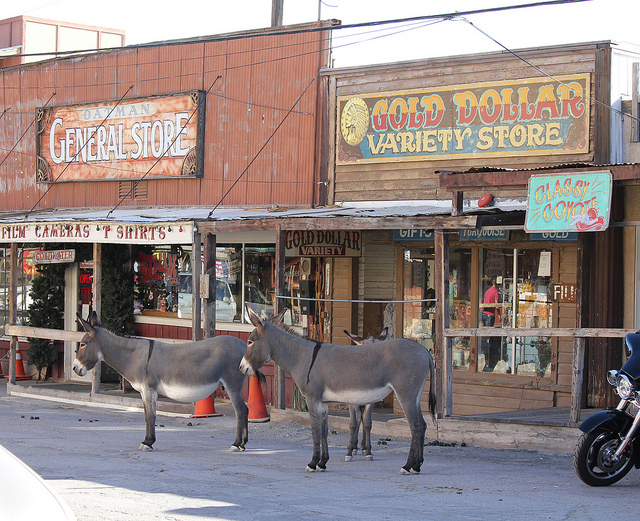 The wild burros are somewhat of a tourist attraction in Oatman, Arizona. Photo via las – initially/Flickr |
In an effort to protect the declining population of wild burros in Arizona back in 1971, Congress passed the Wild Free-Roaming Horses and Burros Act. The act states “It is the policy of Congress that wild free-roaming horses and burros shall be protected from capture, branding, harassment, or death; and to accomplish this they are to be considered in the area where presently found, as an integral part of the natural system of the public lands.” Because of the Wild Free-Roaming Horses and Burros Act, the burros are now under the Bureau of Land Management’s control and protection.
Reportedly, the burros were imported into Arizona in the 1860s and then deserted the animals when mining proved unsuccessful. Around 10,800 of them are now roaming in areas supervised by the Bureau of Land Management, 1,180 are in corrals sponsored by the government and there are now 4,800 unsupervised wild burros in Arizona. The Bureau of Land Management states that that number exceeds what’s appropriate for the land and the burros; they’ve set that number at 1,676, according to The Kansas City Star.
Some of the wild burros have taken to roaming Oatman, a tourist town in the western Arizona. Visitors give them carrots and hay cubes that they can purchase at the town shops and the animals are said to be friendly, though at times a little sneaky (if they see a purse, they just might steal it and run off with it).
Despite being somewhat of a tourist attraction, some Arizona residents say that the burros are causing too many problems, including 36 vehicle accidents in the past three years, The Kansas City Star reports. In addition, the larger the burro population grows, the less natural food there is for the bighorn sheep that are native to the area. In order to alleviate the problem, government officials are considering contraception, training the burros not to enter the towns (which most agree is not at all likely to happen) and an adoption plan. If you happen to be interested in adopting one or more of these Arizona wild burros, visit the Bureau of Land Management adoption page here. Untrained burros can be adopted for $125, while trained burros are adopted for $200.






great info!
I guess I have mixed feelings for these burro/donkeys, because if they are a hazard, government will destroy them, and if adopted out, people will at least save some of them, but there will never be enough homes for all. The best way would be to gelding ALL studs, to lower the number of them.
cool
great info